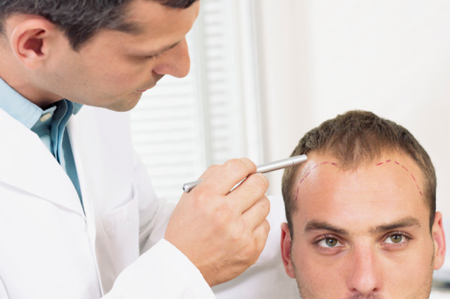
There is a typical pattern or sequence to male pattern baldness. The temples or crown of the head is where hair loss starts, although it can begin in various areas. It takes a number of years for the initial process of hair thinning to begin, and a man can end up completely bald. The most common place hair loss occurs is on the top of the head. There are prescription medications now available to treat MPB. Find out more about the use of online medical consultation for the treatment of hair loss.
Androgenetic Alopecia is Genetic
Millions of men go bald. Every day adults lose approximately 10 thousand scalp hairs. The typical lifespan of hair is five years. The hair is not always replaced and bald spots will appear with male pattern baldness (MPB). Also called androgenentic alopecia, the hair loss process associated with MPB can take a long time, with some men losing hair gradually over the course of three to five years.
Androgenetic alopecia is a disorder where there is a reduction in the terminal-to-vellus hair ration, which is typically four to one. After miniaturization of the hair follicles, only fibrous tracts remain. For people with this condition, there is a usual pattern of hair loss noted, where hair remains in horseshoe pattern on the head. Studies show that self-regeneration of the follicle occurs from stem cells, and these renewed areas are cycled through stages of anagen and telogen.
There is a typical pattern or sequence to male pattern baldness. The temples or crown of the head is where hair loss starts, although it can begin in various areas. It takes a number of years for the initial process of hair thinning to begin, and a man can end up completely bald. The most common place hair loss occurs is on the top of the head. There are prescription medications now available to treat MPB. Find out more about the use of online medical consultation for the treatment of hair loss.
Hair Loss Causes
Men begin going bald for several reasons. However, there is a 95 percent chance that men who start losing hair between 20 and 45 years old end up with male pattern baldness. This is the time to try and prevent baldness or at least slow it down.
Genetic Predisposition – There is a genetic predisposition to male pattern baldness in most men. MBP is produced when the hair follicle is affected by hormones. The enzyme 5-alpha reductase converts testosterone to dihydrotestosterone. The hair follicles are adversely affected by DHT. Hair growth is reduced or stopped when the hair follicle receptor is acted on by the hormone. The hair stock is depleted gradually leading to the normal loss of hair.
Alopecia Areata – You should go to your doctor if you experience hair loss that is the result of an illness or disease. Symptoms of alopecia areaota include suddenly losing hair, clumps of hair falling out, and/or large amounts of hair on your pillow, clothing or with washing. There are a number of causes for hair loss but it can be successfully treated once the cause is identified.
Cancer or Therapy – Noticeable hair loss is often the result of illness or various cancer therapies. Hair loss can also be caused by side effects from treatments and medications such as steroids, chemotherapy, interferon, as well as radiotherapy. These cancer treatments commonly come with the side effect of hair loss.
Various Diseases and Infections – Hair loss can be caused by a number of illnesses and conditions that include the high temperature that comes with flu or an infection, pituitary or thyroid problems.
Aging – Many men have to adjust to the loss of hair and balding when they get older, as this is part of the natural aging process. In addition, a number of conditions and diseases can result in the loss of hair in men. The condition can be reversed by treating the illness that initially caused it.
Stress – Trichotillomania is a psychological problem that causes people to pull their own hair out. Treating the psychological cause should result in the disappearance of the symptoms such as loss of hair.
Chemicals and Substance Exposures – Thallium acetate and other dangerous chemicals, fungal infections of the scalp and burns can all result in the loss of hair.
Baldness Solutions
To reverse or stop hair loss, it is vital to treat diseases, illnesses and fungal infections that cause the disorder. Discontinuing the use of medications that result in the loss of hair can also stop the process. If you are embarrassed about male pattern baldness or hair loss, consult a doctor by using the telehealth method and get a prescription online. You can pick up your prescription at your regular pharmacy or any local pharmacy.
Treatment options include use of 2 to 5% topical minoxidil, finasteride orally, and latanoprost 0.1% solution. Researchers are uncertain how many of the newer medications work, but speculate that they increase or prolong the growing phase in the hair cycle. These medications are proven to help regrow hair for men with various causes of loss and baldness.
Telehealth is a type of health care delivery that has been practiced for several years. Instead of making the trip into see a doctor, you simply turn on your computer and with the aid of a webcam and microphone, you are able to ask a doctor about any medical questions or concerns you may have. Not only is telemedicine being used for consultations, diagnostics and procedures, it is also being used to order prescriptions online. For many men that are balding, as well as those who would like to try online prescription medication, telehealth is a great way to do it!
References
Blume-Peytavi U et al. A randomized double-blind placebo-controlled pilot study to assess the efficacy of a 24-week topical treatment by latanoprost 0.1% on hair growth and pigmentation in healthy volunteers with androgenetic alopecia. J Am Acad Dermatol. Aug 27 2011
Headington JT, Novak E. Clinical and histological studies of male pattern baldness treated with topical minoxidil. Curr Ther Res Clin Exp. 1984;36:1098-106
Magro CM et al. The role of inflammation and immunity in the pathogenesis of androgenetic alopecia. J Drugs Dermatol. Dec 2011;10(12):1404-11.
Olsen EA et al. A randomized clinical trial of 5% topical minoxidil versus 2% topical minoxidil and placebo in the treatment of androgenetic alopecia in men. J Am Acad Dermatol. Sep 2002;47(3):377-85.
Rossi A et al. Finasteride, 1 mg daily administration on male androgenetic alopecia in different age groups: 10-year follow-up. Dermatol Ther. Jul 2011;24(4):455-61.
Stough D et al. Psychological effect, pathophysiology, and management of androgenetic alopecia in men. Mayo Clin Proc. Oct 2005;80(10):1316-22.
[box_light]James is consultant physician and who occasionally writes on health and medical technology related articles. He has written this extensive article on male pattern baldness which is affecting lot of young men these days.[/box_light]

Balanced Diet Beauty Calories Cancer Diet Diet Plan Eating Effective Weight Loss Exercise feat featured fitness Food Fresh Fruits Fresh Fruits And Vegetables Fruits And Vegetables Fruits Vegetables Hcg Weight Loss Health Health Experts Losing Weight Lt Massage Mental health Muscle Natural Diet Nbsp Nutrition Person To Person Physical exercise Physical fitness Pregnancy Pregnant Women Skin Sleep spot Stress Time Period Tooth Weight Loss Weight Loss Diet Weight Loss Products Weight Loss Program Weight Reduction Weight training







Leave a Reply